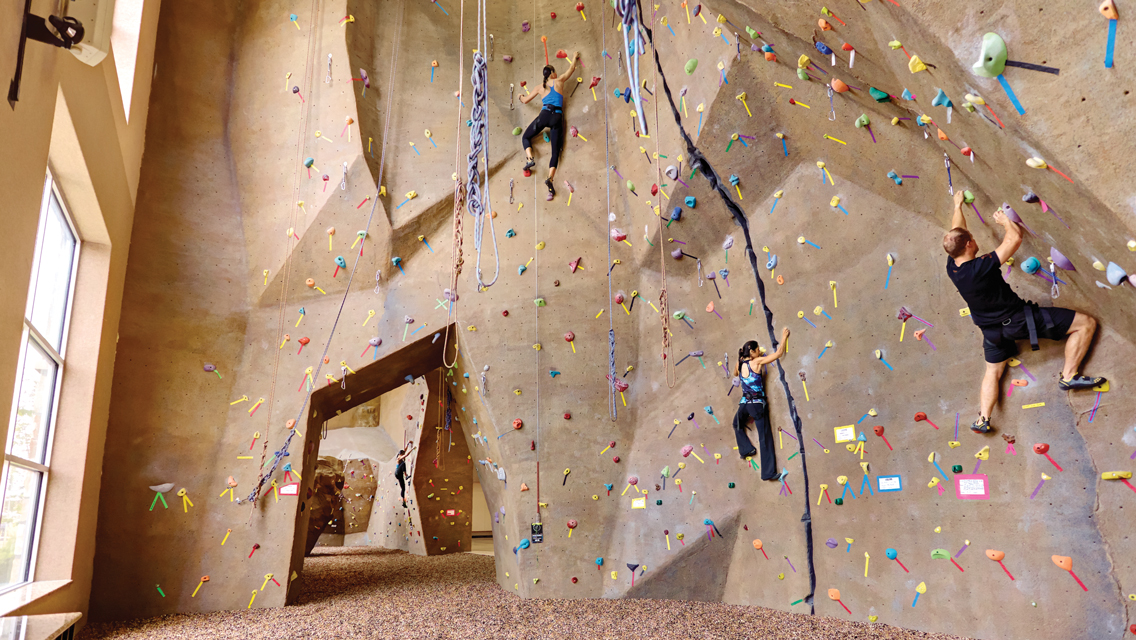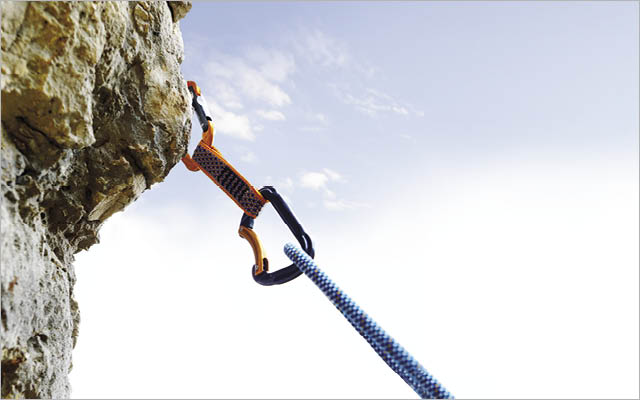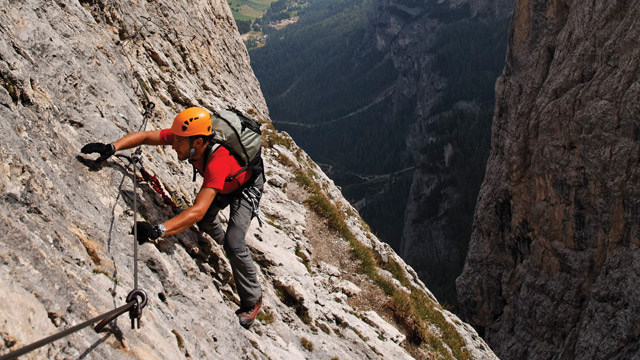When a situation has you “climbing the walls,” it’s rarely a good thing. Except, of course, when it comes to indoor rock climbing. And then it’s a very good thing – for both body and mind.
People of all ages and fitness levels are eager to climb the walls at indoor rock-climbing gyms and studios. Across the country, such facilities are popping up and providing one of the best ways for fitness enthusiasts to cross-train, build overall body strength, increase flexibility, and have fun with family and friends – all while learning new ways to focus and relieve stress.
“Climbing is like a vertical dance, and although it looks very intimidating to someone who’s never done it before, it’s actually very intuitive,” says Eric Hörst, a climbing instructor from Lancaster, Pa., and author of Learning to Climb Indoors. “As kids,” he points out, “we all climbed trees and jungle gyms.”
Not only is climbing an activity our bodies are naturally attuned to do, notes Hörst, but it also provides an amazingly thorough workout, calling into use almost every muscle in the body and deeply engaging our minds in the process.
Now, 20 years after the first indoor rock-climbing facilities appeared in Seattle, the sport is on the rise. In 2005, some 6.7 million people climbed on indoor walls, according to the Outdoor Industry Association in Boulder, Colo. “I started indoor climbing because it was safe, accessible and a great place to meet other people who shared the same interest,” says Kathy Tamanaha, a 37-year-old software tester from Redmond, Wash. “I got hooked right away.”
Learning the Ropes
Indoor climbing is a great way to improve your fitness acumen and physical strength while safely building some excitement into your workout routine. But before you go scrambling up the wall, you’ll want to book a few lessons with a trained instructor who can show you the ropes.
The basics can be learned in one lesson (usually around two hours), according to Hörst. From there, he says, “If you climb just a few days per week for a few weeks, you’ll notice a rapid improvement.”
After reviewing equipment, terminology and safety, the instructor will typically act as the belayer, controlling the ropes from the ground, while you try an easy route by progressively maneuvering handholds with your hands and feet.
From the very start, the importance of using your legs will become apparent because, “You’ll start to feel lactic acid building up in your forearms,” says Joe Iurato, editor-in-chief of Urban Climber Magazine. He reminds new climbers to use their lower bodies for balance, strength, and to avoid fatigue.
Vertical Flow
Many climbers experience total mind-and-body involvement when they scale the walls. Being fully engaged in an activity – a state that psychologist Mihaly Csikszentmihalyi calls “flow” – offers its own rewards. In a state of flow, people often lose track of time and report having feelings of great satisfaction.
In his book, Flow: The Psychology of Optimal Experience, Csikszentmihalyi describes it this way:
“Time flies. Every action, movement and thought follows inevitably from the previous one, like playing jazz. Your whole being is involved, and you’re using your skills to the utmost.”
“The best moments,” he writes, “usually occur when a person’s body or mind is stretched to its limits in a voluntary effort to accomplish something difficult and worthwhile.”
Lizzy Scully, a 33-year-old Colorado-based editor, journalist and climbing enthusiast who has been ascending walls for more than a decade, concurs. “You have to be 100 percent focused on what you’re doing. Climbing helps clear your mind if you’re stressed out, and it’s very meditative.”
Look at any climber’s body, however, and you know that the benefits go far beyond mental equanimity. Thanks to their full-body workouts, climbers are some of the leanest, fittest athletes in the sporting world.
When you reach for a handhold, your triceps, forearms, shoulders, core, lower back and legs are all simultaneously engaged in intermittent, isometric contractions and dynamic movements, says Hörst. The result is stronger, more defined muscles.
There’s some cardio benefit, too. “You’re shifting from strenuous moves to easier ones that allow you to rest,” he explains. “It works like interval training does in running.” Few other workouts provide such breadth of exertion – or such immediate payback.
Scully, who founded and published an online women’s climbing magazine called She Sends, says that climbing’s physical benefits are boundless. She’s able to cross-train for running, hiking, snowboarding and yoga.
And like no other sport, says Scully, climbing bridges the fitness gender gap. “Initially, most men start out by powering through moves, and women are more deliberate, using more core strength and balance,” she says. As climbers improve, however, they learn to combine the best of both approaches and to use their own body’s individual strengths to their best advantage.
Falling for the Sport
It’s normal to find yourself with butterflies in your stomach when you first brave the wall. To help calm your nerves, remember that indoor-climbing facilities are designed specifically for safety.
“If you feel yourself falling, just relax,” advises Iurato. “The belayer controlling the rope will softly stop your fall, and then you can resume climbing.” Trying to fight the impulse to fall, says Iurato, is far more dangerous: It can pull tendons in your fingers and back.
Falls or no falls, be prepared for some muscle tenderness later. “Even if you’ve worked out for years, you’re going to be sore after your first climbs,” says Iurato. “That’s because you’re working all those muscles that you don’t hit with conventional weights.”
It’s worth the twinge, though. Because wherever you end up climbing – at your local fitness center, a dedicated climbing studio or a remote cliff in Asia – you’ll get to enjoy a powerful step up in confidence, athleticism and overall well-being.
Top 4 Tips
You can heighten your indoor-climbing experience by preparing your body and brain with a few pieces of wisdom from wall experts:
1. Favor Your Feet. Climbing looks like it’s all about the arms, but it’s actually your lower body that gives you a lift. This means keeping your weight on the inside of your feet. “The most fundamental thing in climbing is to maximize the use of your leg power,” says Eric Hörst, author of Learning to Climb Indoors. “So you want to try to maintain your center of balance over the top of your feet.”
2. Master Your Midsection. “Climbing requires a lot of abdominal strength,” says Joe Iurato, editor-in-chief of Urban Climber Magazine. “Core strength will allow you to keep your feet in position and will relieve your hands. Think of your core as the messenger between your arms and legs.”
3. Be a Hipster. For more balance and better reach toward the next hold, try this trick from Iurato. If you’re reaching with your right hand, turn your right hip into the wall; the same goes for the left side. “Do that constantly, even on very simple climbs,” he says. “You’ll feel lighter and climb faster and more efficiently.”
4. Grip Lightly. “Grab the hold like an egg,” says Iurato. “Otherwise, you’re overgripping, which will tire out your forearms very quickly.” (See “6 Tips to Build Grip Strength.”)
Don’t Fall for Urban Climbing Myths
Myth: You need megamuscles to master the sport.
Fact: “You don’t need to be superstrong to start climbing,” says Eric Hörst, a climbing instructor from Lancaster, Pa. “In fact, bulky muscles become dead weight that you carry up a climbing wall.”
Myth: Climbing is for experts.
Fact: “You’re going to walk into the gym and see people doing things that you think are impossible,” says Joe Iurato, editor-in-chief of Urban Climber Magazine. “These people started off just like you did. So don’t let it bug you if you watch people running up the wall like Spider-Man – you’ll get there, too.”
Myth: Climbing is a complicated, all-day affair.
Fact: Unlike outdoor rock climbing – which typically requires you to drive to a distant location and set up the ropes – indoor climbing can be done right around the corner in most cities. Plus, climbing gyms supply the gear and do virtually all of the preparations for you. Two hours is the perfect duration for an indoor climb, says Iurato: enough for plenty of climbs, plus rest breaks.
Gear Guide
What you’ll need to get up the wall.
- A harness goes around your waist and upper legs.
- A carabiner, or clip, keeps your harness attached to ropes, and the ropes to each other.
- Ropes are typically attached to an anchor at the top of the wall for “top roping.”
- Climbing shoes with sticky rubber soles help your feet “smear” or grip the wall (you can climb in regular athletic shoes, too).
- Chalk prevents your sweaty palms from slipping.If you’re interested in buying your own equipment, don’t buy used gear, especially harnesses, carabiners or ropes, which could be unsafe, says climber Matt Burbach, author of Gym Climbing: Maximizing Your Indoor Experience.




